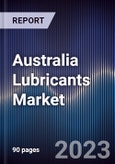Market Overview:
According to publisher estimates, the Australia Lubricants market is growing at a steady rate with a CAGR at ~% owing to the country high oil imports. Strong delivery network accompanied by authorized distributors to reach out to customers through both online and offline modes led to an increase in the overall sales of lubricants in the Australia. Up-scaling Manufacturing Industry, Escalating Construction, Automotive and Marine Industries are major growth drivers for Australia Lubricants MarketBio-lubricants and lubricants with reduced fuel consumption are the major trends among end users in Australia Lubricants Market.
Market is expected to witness an increase in the consumption of lubricants due to rapid growth in industrialization and infrastructural developments, rising private and government investments; cost effective manufacturing operations
Lubricants Industry concentration is at a moderate level, with the four largest companies estimated to account for approximately 40% of industry revenue in 2022-23.
Key Trends by Market Segment:
- By Type of Lubricant: The boosting sales of automobiles in the country have significantly led to the increased consumption of automotive lubricants than industrial lubricants. The increased sales were also supported by the continuous improvement in the refining process of the existing players and the upgradation of refineries by the lubricants giants operating in the country
- By Distribution Channel: Most of the lubricants consumed by the industrial sector of the Australia have been supplied by the widespread network of authorized and local distributors across various regions of the Australia. Distributors might be dealing in a particular brand or can have multiple brands of lubricants that are used for industrial purposes. Distributers are in direct contact with the company, thus creating the trust among the customers to buy genuine products from them
Competitive Landscape
In Australia Lubricants Market, there are about ~ players operating in the overall market, and the top 5 players accounted for ~% share in the market in terms of revenue. The major parameters on which these players complete include product portfolio, distribution network, clientele, partnerships, product pricing, and more.Future Outlook
Increasing production and sales of light commercial vehicles as well as heavy duty vehicles, primarily for trade transport is expected to propel demand for automotive lubricants across Australia in the coming years.Additionally, growth in automotive repair services market across the country coupled with rising adoption of synthetic and semi-synthetic lubricants is further anticipated to fuel growth in Australia automotive lubricants market during the forecast period.
Additional benefits of purchasing an enterprise license:
- TAM/SAM/SOM Analysis
- Customer Cohort Analysis
- Marketing Initiatives
- White Space Opportunity Analysis
- Interactive Data Visualizations
- Customization: 20 Analyst Hours
- 3 Months Post Sales Analyst Support
- Complimentary Update Next Year
- Custom Webinars
Table of Contents
1. Executive Summary3. Australia Lubricants Market Size, 2017 - 20226. Australia Lubricants Future Market Size, 2022 - 20278. Analyst Recommendations9. Research Methodology10. Disclaimer11. Contact Us
2. Australia Lubricants Market Overview
4. Australia Lubricants Market Segmentation
5. Competitive Landscape
7. Australia Lubricants Future Market Segmentation
Companies Mentioned (Partial List)
A selection of companies mentioned in this report includes, but is not limited to:
- BP Australia
- ExxonMobil
- Puma
- Caltex
- Viva Energy Holding
- Ampol
- Penrite
- TOTAL Oil Australia Ltd
- Fuchs Lubricants (Australasia) Ltd
- Phoenix Lubricant Ltd








